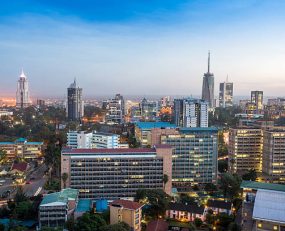
The Express Logistics market in Sub-Saharan African is now worth €2,637.1m according to Ti’s Market Sizing and is due to grow by a CAGR of 5% until 2026. Ecommerce and the resulting express Logistics in Africa is set to change drastically over the next decade. While the Covid 19 pandemic alongside an expected slowdown in the global economy will suppress growth in 2022 and 2023, the long-term trend of the market is one of significant growth. This is due to a combination of a growing middle class and a young tech-savvy population.
According to the African Development Bank, the African middle class has more than tripled in size in the 30 years between 1980 and 2010, this growth has continued and is reflected by consumption on the continent growing from €440b in 2010 to over €1 trillion in 2016 according to the Harvard business review.
Who are this middle class?
Of the 10 youngest countries in the world, all are in Sub-Saharan Africa. Data from Pewresearch shows that in 2017 those aged 18-29 were over 30% more likely to own a smartphone in South Africa, Kenya and Ghana than those 50+. According to GSMA the number of smartphone connections in the region reached 302 million in 2018 and is expected to rise to nearly 700 million by 2025. Smartphones are now becoming a part of everyday life for young Africans and with cheap Chinese smartphones being sold for as little as $20 they’re being used by the continent’s rich, poor, urban and rural populations. These smartphones are also being accompanied by improved telecommunications infrastructure. 4G coverage in sub-Saharan Africa nearly doubled in the two years from 2017 to 2019 reaching 50%. By 2025, 4G adoption is expected to reach 28% while that’s less than half the global average it’s still some 700 million Africans with a 4G connection. Africa’s next generation of young adults will provide a large tech-savvy consumer base with the power to push further growth in ecommerce.
What does this mean for ecommerce in the Region?
The combination of a growing middle class and greater smartphone use provides an environment that encourages eCommerce purchases. According to Statista monthly visitors to Africa’s Top 3 ecommerce sites stood at 32 million for Nigeria’s Jumia, 10 million for South Africa’s Takealot and 3 million for Nigeria’s Konga. The growth of these companies has encouraged global giants to make their move, Business Insider South Africa reported that Amazon plans to enter the sub-Saharan African eCommerce market with new online marketplaces in Nigeria and South Africa in H1 2023 under the project codename ‘Fela’. While Amazon already had a presence in South Africa through its Amazon Web Services the company aims to roll out Amazon Prime memberships in 2023 as it goes head-to-head with Takealot, Jumia and Konga in the African Ecommerce market.
Historically Multinational companies have invested in Africa to gain from the potential revenues from natural resources. In future, Africa’s value may sit with its consumers as foreign companies see the potential revenue from an active middle class.